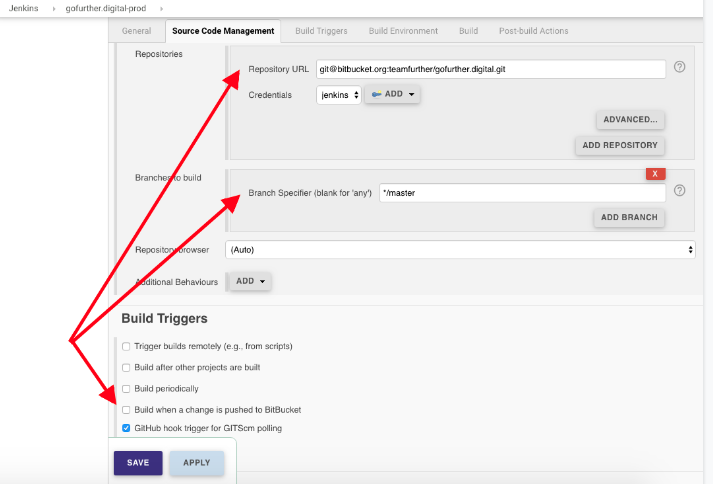Server & CI/CD Set-up
Owner: Project Lead Last revision: 22.07.2022
A guide to installing LEMP Stack (Linux - nginx - MariaDB - PHP) on VPS and setting up a continuous deployment process from a Github repository.
Linode#
Our preferred VPS provider is Linode. The below pages are taken from their guidelines, but should apply to any VPS provider.
Firewall#
$sudo ufw enable$sudo ufw allow ssh$sudo ufw allow http$sudo ufw allow https
nginx#
$sudo apt-get install nginx- Go to
{ip}in your browser, you should see Welcome to nginx! page. If it’s not running, then:$sudo service nginx start
DNS#
Our preferred DNS provider is Cloudflare.
- Create an
Arecord pointing to{ip} - Configure production and staging websites in
/etc/nginx/sites-available/ - Go to
{url}
SSL#
- Install Certbot ↗
$sudo certbot certonly --nginx- Test automatic renewal with
$sudo certbot renew --dry-run - Update nginx configuration in
/etc/nginx/sites-available/ - Check if SSL certificate is working
PHP#
$sudo apt-get install software-properties-common$sudo add-apt-repository ppa:ondrej/php$sudo apt-get update$sudo apt-get install php8.1-fpm php8.1-cli php8.1-common$sudo apt-get install php8.1-curl php8.1-gd php8.1-mbstring php8.1-mysql php8.1-xml- Check status with
$service php8.1-fpm status // check status. If it’s not running, then$sudo service php8.1-fpm start
MariaDB#
$sudo apt-get install mariadb-client mariadb-server$sudo mysql_secure_installation- If you can’t connect to mysql with root user:
sudo mysqlUPDATE mysql.user SET plugin = 'mysql_native_password';FLUSH PRIVILEGES;
- Create database and user
mysql -u root -pCREATE DATABASE {database};CREATE USER '{username}'@'localhost' IDENTIFIED BY '{password}';GRANT ALL ON {database}.* TO {username}@`localhost`;FLUSH PRIVILEGES;
PhpMyAdmin#
$sudo apt-get install phpmyadmin$sudo ln -s /usr/share/phpmyadmin /path/to/project/public/folder
Never leave it installed for projects in production!
Composer#
$curl -sS https://getcomposer.org/installer -o composer-setup.php$sudo php composer-setup.php --install-dir=/usr/local/bin --filename=composer- Check of correctly installed
$composer - Install
unzip, which is necessary forcomposer install$sudo apt-get install unzip
GIT#
- Generate SSH key (for
rootuser)$ssh-keygen -t rsa
- Set up SSH key in Github
$cat ~/.ssh/id_rsa.pub- Copy key to clipboard
- Go to
Github repository -> Settings -> Deploy keysand add your key
-
$sudo apt-get install git $mkdir /var/www/{appdomain.com}$sudo chown -R www-data:www-data /var/www/{appdomain.com}$cd /var/www/{appdomain.com}-
$git clone [email protected]:{repo_url}.git . $mkdir /var/www/{staging.appdomain.com}$sudo chown -R www-data:www-data /var/www/{staging.appdomain.com}$cd /var/www/{staging.appdomain.com}$git clone [email protected]:{repo_url}.git .$git checkout staging // or develop
NPM#
$sudo apt-get install npm$sudo npm install --unsafe-perm
Jenkins#
- Create script file on CI/CD server in
/var/lib/jenkins/scripts - Set up Jenkins pipeline
- Clone an existing project
- Change repo
- Change script file path
- Add deploy keys to GitHub repo (
Settings / Deploy keys) for user that handles pull on remote server (usuallyroot, as commands run withsudo) - Create push webhook on GitHub repo (
Settings / Webhooks):https://ci.gofurther.digital/github-webhook/ - Make sure the CI/CD server
jenkinsuser has SSH access to remote server- Create
jenkinsuser on remote server and givesudorights - Add
jenkinspublic key to~/.ssh/authorized_keyson remote server - Add line
jenkins ALL=(ALL) NOPASSWD: ALLto/etc/sudoerson remote server - Add remote server to
~/.ssh/known_hosts
- Create
- Clone GIT repo into
/var/build(and/var/wwwif you haven’t done o yet)
Backups#
All the following step shall be done on the CI/CD server:
- Create script file on CI/CD server in
/var/lib/jenkins/scripts/backups - Set up Jenkins pipeline
- Clone an existing project
- Change script file path
- Make sure the CI/CD server
jenkinsuser has SSH access to remote server- Create
jenkinsuser on remote server - Add
jenkinspublic key to~/.ssh/authorized_keyson remote server - Add remote server host key to
~/.ssh/known_hosts
- Create
- Make sure the remote server
jenkinsuser has rsync access to backup server- Add
jenkinspublic key to/.ssh/authorized_keyson backup server - Add backup server host key to
~/.ssh/known_hosts
- Add

